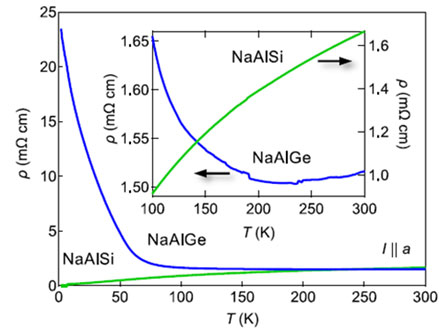PC-4-2
Superconductivity induced by hole-doping in the nodal-line semimetal NaAlGe
17:15-17:30 28/11/2023
*T. Ikenobe1, T. Yamada2, D. Hirai1†, H. Yamane2 and Z. Hiroi1
1. Institute for Solid State Physics, University of Tokyo, Chiba 277-8581, Japan
2. Institute of Multidisciplinary Research for Advanced Materials, Tohoku University, Sendai 980-8577, Japan
†Present address: Department of Applied Physics, Nagoya University, Aichi 464-8603, Japan
Recently, correlated Dirac electron system have attracted much attention in the material research field. It is predicted that correlation effects in the nodal-line bands will lead to various ground states, such as antiferromagnetism, excitons, and superconducting phases, but few candidate materials are available. [1,2] In this context, we focus on the nodal-line semimetal NaAlGe, which has a nodal-line band near Fermi energy and an anomalously large Wilson ratio of 10. Moreover, NaAlGe exhibits semiconductive electrical resistivity at low temperatures (Fig. 1), indicating the formation of a pseudogap at approximately 100 K; the origin of the pseudogap in NaAlGe may be associated with excitonic instability.[3]
In this work, we investigated hole-doping effects on the ground state of the solid solution Na(Al1–xZnx)Ge by electrical resistivity, magnetic susceptibility, and heat capacity measurements. ** **It was found that hole doping causes the appearance of a superconducting phase instead of a pseudogap phase. In the presentation, the relationship between superconductivity and pseudogap phases will be discussed.
Figure 1: Electrical resistivities ρ of NaAlSi and NaAlGe single crystals measured with an electric current along a axis.
[1] A. N. Rudenko, et al., Phys. Rev. Lett. 120, 216401 (2018),
[2] M. M. Scherer, et al., Phys. Rev. B 98, 241112(R) (2018),
[3] T. Yamada, et al., J. Phys. Soc. Jpn. 91, 074801 (2022).
The authors are grateful to Yoshihiko Okamoto for insightful discussion. This research was financially supported by JSPS KAKENHI Grants (JP20H02820, JP20H01858, JP22H04462 and JP22H05147) and Cooperative Research Program of “Network Joint Research Center for Materials and Devices” (20225008).
